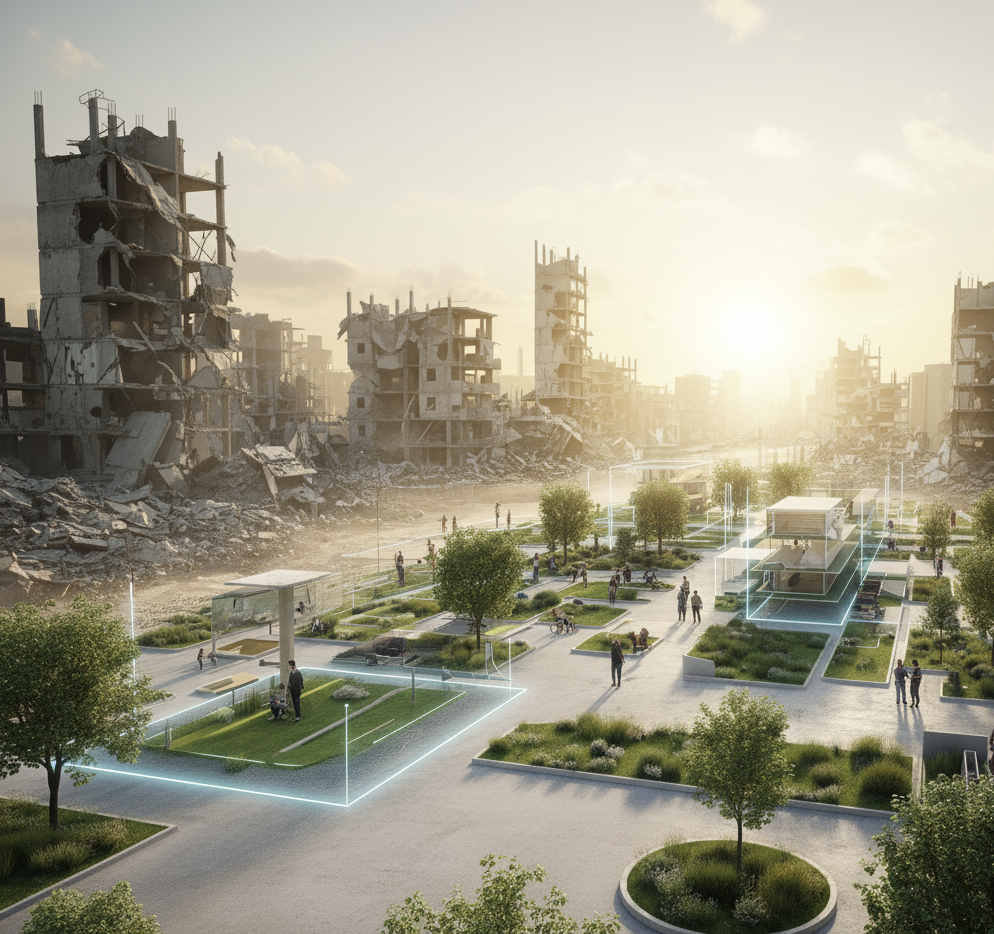An op-ed reframing Gaza’s reconstruction through spatial justice and sustainable regional planning—from debris and tenure to resilient housing and infrastructure.
To name things honestly is to admit that what collapsed in Gaza was not only concrete and steel, but a spatial order: a web of everyday life stitched together by proximity, memory, and the quiet functions of the city. Yet within the harshness of destruction lies a narrow opening for thought—a chance to reconsider how space holds society. That opening should not be filled with concrete alone, but with sturdier principles: spatial and social justice, dignified housing, and an urbanism resilient enough to withstand long emergencies.
The first task is not engineering; it is knowledge. This is not a luxury of maps and models, but a baseline of reality: Who lives where? What remains safe? Where have service gaps widened into chasms? In moments like these, personal testimonies tangle with disrupted mental maps, while boundaries and rights blur. Here science can serve as the thread that stitches memory back to ground truth: fresh aerial imagery not to dazzle, but to reconcile our eyes with what exists; swift site reconnaissance that recognizes neighborhoods not as colored polygons, but as living organisms with pulses and paths—children walking to school, elders reaching the clinic, traders moving to market. This is not a statistical hobby; it is a moral compass. We must know, so that we do not reproduce injustice in a newly poured form.
Debris often invites a binary narrative: a suffocating burden or a windfall of free building material. On the ground, the truth sits uneasily between both. Debris is a contaminated wealth—a resource wrapped in risk. In a fragile environment, dealing with it becomes an ethical test of planning as much as an engineering one. The line separating circular local economy from long-term environmental harm runs through a series of small, cumulative decisions: choosing where staging yards go, when trucks move and by which streets, who verifies quality when rubble returns as sub-base or non-structural block, how hazardous traces are handled or—if ignored—left to drift into soil and lungs. Turning what fell into what reconnects streets is not a matter for emergency reflexes alone. It requires fairness—labor that hires locally, transparent tracking of loads, public standards of quality—so cleaning the city becomes the beginning of healing rather than a new wound.
Property is the knot at the heart. Here you speak of dense camps and plot lines worn into memory more than into law; homes known by families’ names rather than parcel numbers; a collective recollection of “boundaries” traced by children’s footsteps, not seals on deeds. If mishandled, reconstruction risks stripping social legitimacy even as walls rise true. The guiding principle is disarmingly simple: secure people’s right to return and to continue living within their neighborhoods first; let the finer legal settlement proceed in a parallel track that does not halt life. Contemporary tools can support—rather than steamroll—this truth: precise point addresses linked to households, participatory documentation that folds in testimonies and whatever proofs exist, a swift, visible grievance process; and above all, restraint from uprooting in the name of “order.” Spatial justice is measured less by neat drawing lines than by whether people can recognize themselves in the places they return to.
Infrastructure follows—not as pipes and wires alone, but as an ethical scaffold for the city. The deeper meaning is that service corridors precede walls: emergency routes that stitch clinics and supply points, water and sanitation repaired where possible and supplemented by modest, modular systems where necessary, distributed energy that keeps sensitive facilities breathing even if the larger grid stutters. This is not gadgetry; it is the only way neighborhoods avoid becoming hostage to a constant drip of small crises. Designed with life-cycle costs in mind rather than momentary purchase prices, such networks convert “repair” into an opportunity to embed intelligence: reducing leakage, modest storage that matters, rainwater management that respects rather than fights the natural basins of the urban landscape.
As for housing, Gaza’s story is not merely about roofs and walls. It is the story of social relations that must not be dissolved by well-intentioned geometry. There is wide territory between copying informality and erasing memory under the flag of modernization. In that terrain, a housing grammar can emerge that fuses smart density to the cultural residue of courtyards, thresholds, and privacy. Small blocks that grow and rise judiciously; semi-communal courtyards returning shade, air, and social ease; nearby mixed-use spines that reduce forced travel and nourish neighborhood economies rather than exporting them to the city’s edge. The technical repertoire is not exotic: cross-ventilation that crowds out the worst of heat stress, reflective roofs, a roofscape already prepared for photovoltaics, modest solar hot-water clusters. These are not “green ornaments”; they are economies of survival when resources grow costly and disruptions lengthen.
The hardest question is priority. In the rush of rebuilding, places with louder voices or stronger leverage tend to surge to the front. Spatial justice reframes priority into something measurable and defensible: social fragility, glaring service deficits, suffocating densities with no escape valve, service corridors that must function first. When such criteria are published and applied consistently, funding becomes a covenant rather than an expenditure: resources flow not to the loudest or the largest, but to projects that shorten the walk to school, restore potable water to a network, deliver structurally safe units within the same neighborhood, reduce the daily cost of time and health. Transparency is not an administrative appendix—it is the oxygen of trust. A simple public dashboard, even a humble one, can correct institutional behavior more than any parade of speeches.
Reconstruction also has temporal natures that deserve clear eyes. The first months are not for monumental projects; they are for suturing the city: opening lifelines, neutralizing imminent hazards, propping up small services that keep neighborhoods alive. The first year is for alchemizing rubble into infrastructure, for beginning modular, expandable fixes to neighborhood networks, for handing over the first dignified homes. The following years deepen and interconnect: permanent facilities, stronger networks, floors added where foundations permit, temporary clinics and schools turning into lasting presences. Progress should accrete as small, provable wins rather than as theatrical leaps that curdle into frustration.
Governance here need not mean a heavy pyramid pressing on people’s backs. It should be a balanced instrument: a lean coordinating center that sets standards and unblocks snarls; nimble local arms that know alleys and family names and negotiate reality day by day. We know this from cities everywhere: centralism without field agility makes for tone-deaf works; agility without standards slides into exhausting improvisation. Between them grows the habitat of meaning: concise permits in place of queueing paper, local jobs flipping residents from recipients into partners, complaint lines that actually close cases rather than sleep in a suggestion box.
Why this insistence on language—on justice, memory, dignity—when the topic appears to be concrete and rebar? Because a city is not inert matter. A city is an ethical relation between people and place. If Gaza returns with taller blocks and wider streets but loses the capacity to cradle its neighbors, we will have mended the body and left the soul outside the door. Spatial justice, in this light, is not a political slogan; it is the daily logic of life: a child who does not walk an hour to a school that could be ten minutes away; an elderly woman who reaches a clinic on a route that does not drown at the first cloud; new homes raised from old materials without importing their hidden poisons; a neighborhood name that still means something to its children—and not only to its contractors.
One might object that this is idealism in a reality of constraints. Perhaps. But the alternative is not “realism”; it is resignation to disorder: hurried building that forgets the questions which return a few years later, oversized contracts never judged by outcomes, neighborhoods added to maps as numbers rather than as human beings. What is proposed here is not a rigid program but a way of thinking: put at the center the things that never appear in ribbon-cuttings—travel time, air quality, dampness in walls, the ability of a courtyard to gather neighbors—and let these become the compass by which we judge every spatial decision.
We do not need superheroes. We need decision-makers who understand that dignity lives in small details; engineers who know that the most beautiful plan is the one felt in the calm of the night, not the noise of an inauguration; and communities whose voices are engaged not to cry out, but to be situated in the right place in the equation. Only then does building become an act of restoring meaning as much as restoring shelter; and only then can Gaza—having known loss intimately—teach the world what a just return to place might look like.

